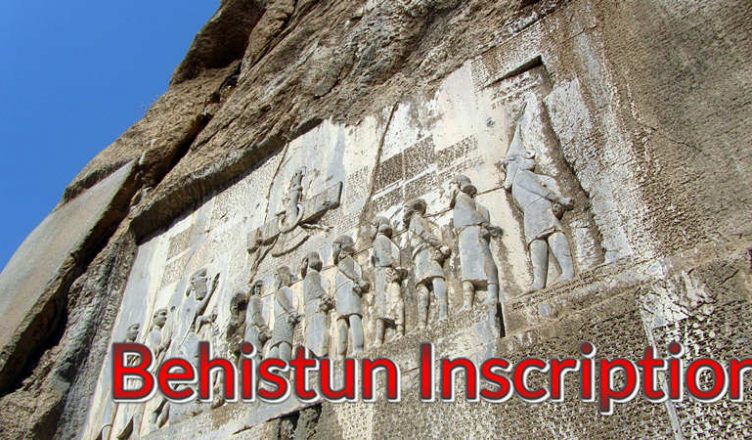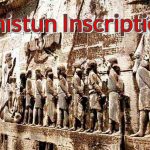The Behistun Inscription, situated amidst the majestic Iranian mountains, is one of the world’s most spectacular rock carvings. This carving is not just an ancient historical relic; it’s a grand inscription that bears the illustrious history of the Persian Empire. Engraved on this colossal rock scroll are three languages: Old Persian, Elamite, and Akkadian, documenting the splendid achievements and political acumen of King Darius the Great of the Persian Empire. Its discovery and decipherment marked a new era in our understanding of the ancient Near Eastern world. In this article, we will delve into this awe-inspiring relic, exploring how it has reshaped the landscape of historical research, revealing the rise and fall of the Persian Empire, and its enduring impact. Here are 8 fascinating facts about the Behistun Inscription:
1. Carved Chronicles of the Ancient Persian Empire:
The Behistun Inscription is a carving from the 6th century BC of the Persian Empire. This ancient billboard consists of four cuneiform panels surrounding a group of 3D figures, etched into a limestone cliff. These figures are carved approximately 300 feet (90 meters) above the Royal Road of the Achaemenid dynasty, which is today known as the Kermanshah-Teheran highway in Iran.
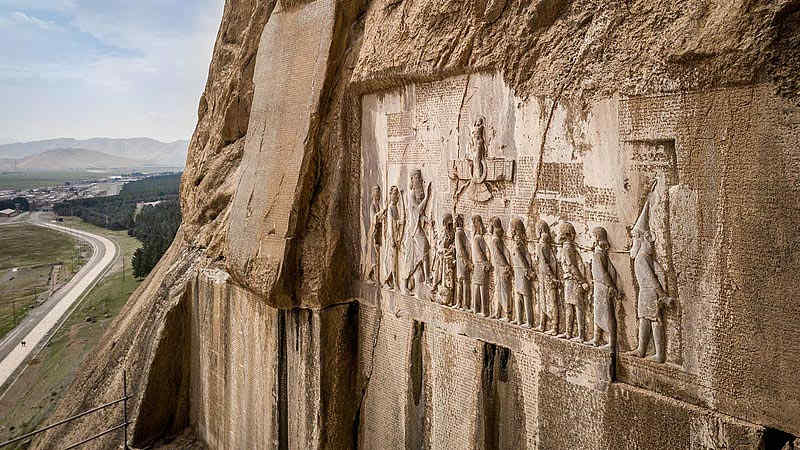
The inscription is located near the town of Bisotun in Iran, about 310 miles (500 kilometers) from Tehran and approximately 18 miles (30 kilometers) from Kermanshah. The figures depict the Persian king Darius the Great stepping on his predecessor and rival, Gaumata, with nine rebel leaders standing before him, connected by ropes around their necks. These figures are roughly 60×10.5 feet (18×3.2 meters) in size, and the four text panels are more than twice the overall size, forming an irregular rectangle of about 200×120 feet (60×35 meters), with the lowest part of the carving standing over 125 feet (38 meters) above the road.
2. The Glorious Epic of Darius the Great:
The Behistun Inscription was commissioned by the Persian King Darius the Great to extol his magnificent achievements. It is written in three languages: Elamite, Old Persian, and Akkadian, and it is carved into the sheer cliff face, serving as a testament to the grand military victories of the Persian King and leaving behind an important historical inscription for future generations.
After quelling internal turmoil and stabilizing the state, Darius the Great journeyed from Babylon to Ecbatana, passing through the village of Behistun, which lies 32 kilometers to the east of Kermanshah. In this village, there was a steep, towering rock face that resembled a mirror that reached into the sky. In front of this mountain was a vital road that connected the Babylonian River to Hamadan. Below the mountain, there was a pond that never dried up, suitable for military use. The ancients referred to this place as a “sacred site” with a hint of religious mystique. Seeing this precipice, Darius the Great, full of pride, decided to carve his accomplishments into it, giving rise to the Behistun Inscription, which has endured for millennia.
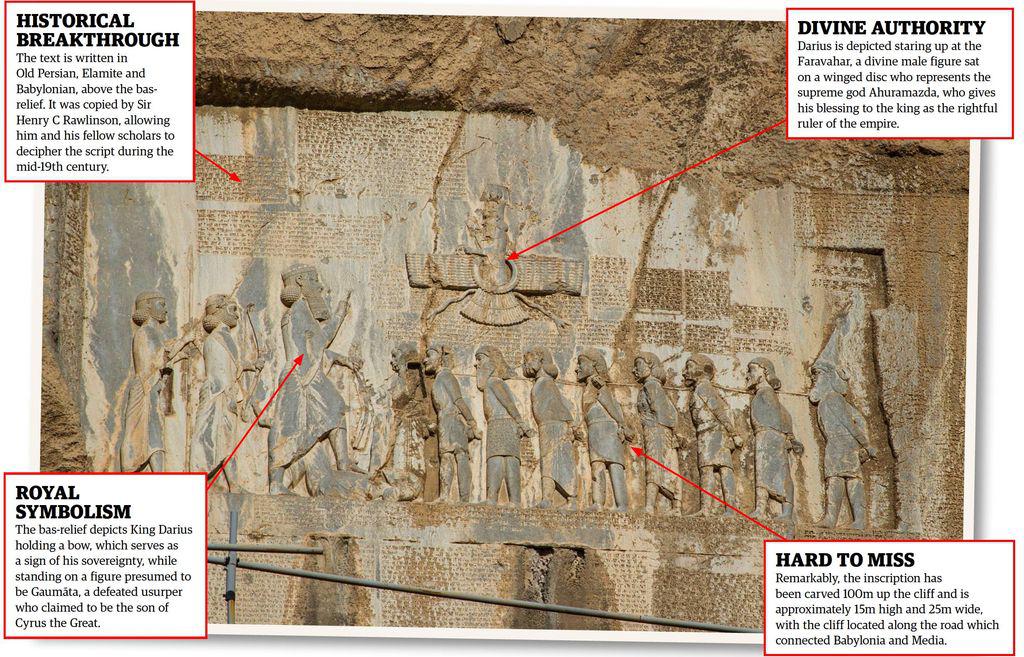
3. The Behistun Text:
The text on the Behistun Inscription, much like the Rosetta Stone, constitutes a parallel text, a text in two or more written languages placed side by side for the purpose of comparison. The Behistun Inscription is recorded in three different languages: in this case, Old Persian, Elamite, and cuneiform Akkadian, a dialect known as Neo-Babylonian. Similar to the Rosetta Stone, the Behistun text was instrumental in deciphering these ancient languages, including the earliest-known use of Old Persian, a branch of Indo-Iranian languages.
A version of the Behistun Inscription written in Aramaic, the same language as the Dead Sea Scrolls, was found on papyrus scrolls in Egypt, likely dating to the early reign of Darius II, approximately a century after the stone was carved. For more details about the Aramaic script, you can refer to Tavernier (2001).
4. Darius the Great’s Power and Humiliation:
The carving of the inscription began in December of 521 BC and was completed around March of 518 BC, taking two years and three months to finish. Above the inscription is a bas-relief that is 3 meters high and 5.48 meters long, depicting Darius receiving captives. In the relief, Darius stands at a height of 1.8 meters, approximately life-sized, with a dignified stance. Behind Darius are two guards, the nobleman Gobryas and Aspathines. Darius places his left foot on the rebel leader Gaumata, holds a bow in his left hand, and points his right hand towards Ahura Mazda in the central sky as a gesture of reverence. Ahura Mazda is the supreme god in Zoroastrianism, depicted high above, with his left hand holding a ring symbolizing kingship, ready to bestow it upon Darius, and his right hand offering a blessing. In front of Darius are the eight of the “Nine Kings Captured,” with the ninth, King Kunga, added later. These figures of the nine captives are only 1.2 meters high, symbolizing their humiliation, with their necks bound by a long cord and their hands tied behind their backs.
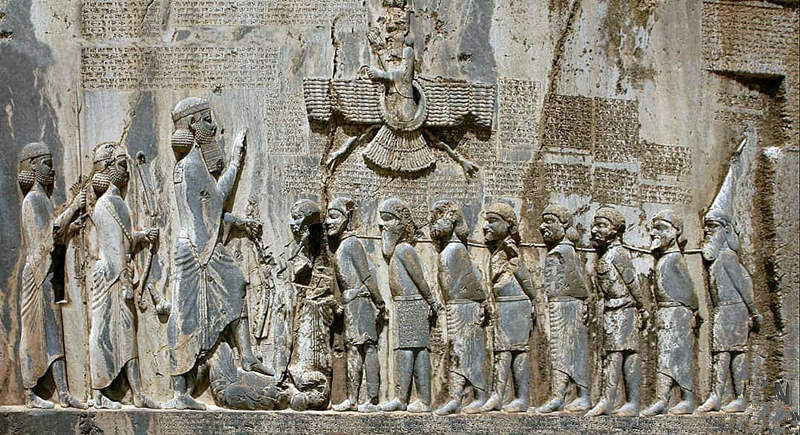
5. Darius the Great’s Consolidation of Power and Divine Proclamation:
Below the bas-relief is the main text, written in cuneiform script in three languages: Old Persian (414 lines), Elamite (593 lines), and Akkadian (112 lines). The content can be divided into three main sections. The first section establishes Darius’s legitimate succession to the throne, the second boasts of his achievements in quelling the rebellion, and the third proclaims the divine nature of his kingship, declaring it inviolable.
The discoverer of the Behistun Inscription was Henry Rawlinson, a British army officer, Orientalist, and former Member of Parliament, who served as a diplomat in Iran. He was also an amateur archaeologist with a deep fascination for the ancient Persian cuneiform inscriptions. In 1835, he found the Behistun Inscription. To study it, he climbed the perilous cliff, risking his life to create rubbings of the entire inscription. Through his efforts, the text was successfully deciphered, causing a significant stir in the Western archaeological and historical community.
In the inscription, Darius accuses his enemies of “lie,” branding them as followers of Ahriman, representing darkness, falsehood, hunger, greed, hatred, disease, and death. Darius portrays himself as a follower of Ahura Mazda, embodying virtue, wisdom, purity, and sincerity, just as he proclaimed.
6. Royal Propaganda:
The Behistun Inscription’s text details the early military actions of King Darius I of the Achaemenid dynasty (reigning from 522 to 486 BC). It was carved shortly after Darius ascended the throne, between 520 and 518 BC, and provides autobiographical, historical, royal, and religious information about Darius. The Behistun text serves as one of several propaganda materials aimed at legitimizing Darius’s rule.
The text also includes Darius’s genealogy, lists of his ethnic groups, the circumstances of his ascension to the throne, accounts of several failed revolts against him, a list of his royal virtues, instructions for his descendants, and details about the creation of the text.
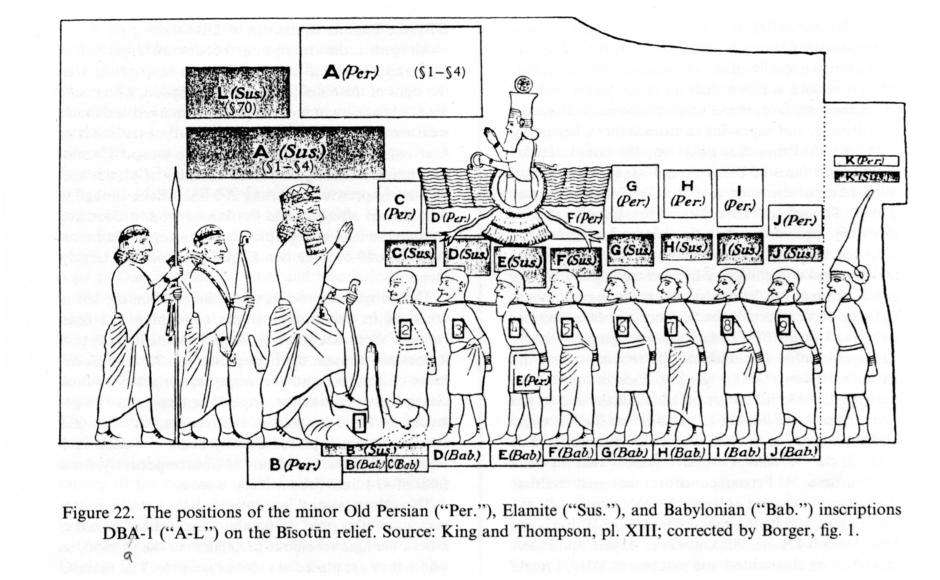
7. Political Bravado and Ceremonial Politics:
Most scholars agree that the Behistun Inscription contains elements of political bravado. Darius’s primary aim was to establish the legitimacy of his claim to the throne of the Achaemenid Empire, to which he had no bloodline connection. Other parts of Darius’s boasting can be found in these passages in the three languages, as well as in the large construction projects at Persepolis and Susa, in the tomb complex of Cyrus at Pasargadae, and in his own tomb at Naqsh-i-Rustam.
Historian Jennifer Finn (2011) has pointed out that the location of the cuneiform was too high above the road to be read, and almost no one could read when the inscription was carved. She suggests that the written part served not only for public consumption but also had a ceremonial aspect, transmitting information about the king to the universe.
8. A Precious Document Unveiling the Early History of the Persian Empire:
For contemporary individuals, the Behistun Inscription is not only a magnificent historical relic but also a valuable historical document. Its significance as a historical document is multi-fold. Firstly, the Behistun Inscription provides the first detailed account of the early history of the Achaemenid dynasty (the Persian Empire) and enumerates the genealogy of the Achaemenid family, offering crucial data for research in this field. Secondly, the inscription comprehensively records the various political upheavals that took place between 522 and 520 BC. For instance, it provides detailed accounts of significant events such as the revolt of Gaumata, the death of Gombises, Darius’s coup, and Darius’s suppression of the rebellion, surpassing the records of any classical writers. Finally, it strongly supplements the accounts of classical writers regarding the Achaemenid dynasty, confirming or refuting the historical narratives of classical authors in their works, thus providing an important reference for reevaluating the authenticity and value of the works of classical writers.
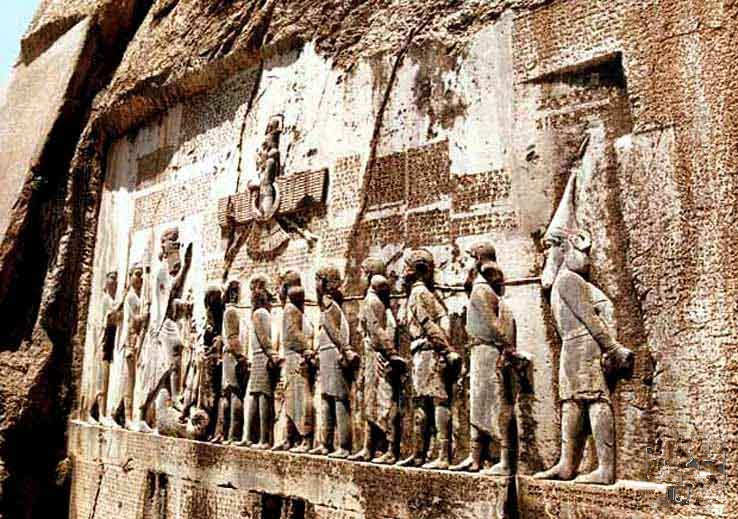
END:
The discovery and decipherment of the Behistun Inscription have laid the foundational conditions for understanding Old Persian, fundamentally reshaping our existing notions of politics, economics, culture, and various aspects of the ancient world. This monumental inscription, with its three parallel versions in Old Persian, Elamite, and Akkadian, represents a watershed moment in our comprehension of ancient history.
With the Behistun Inscription, a gateway to the past has been opened, leading us to a deeper understanding of the political and cultural developments in the ancient Near East. The legacy of Darius the Great’s political aspirations, his conquests, and his vision of a stable, multi-ethnic empire has been inscribed in stone for posterity.
Looking forward, the Behistun Inscription will continue to be a vital resource for researchers, scholars, and historians, offering insights into the complex history of the Achaemenid Empire and its interactions with other cultures of the time. As technology and research methods advance, we can anticipate further revelations and refinements in our understanding of this remarkable historical artifact. The inscription’s influence on the study of ancient languages, the archaeology of the region, and the reconstruction of early Persian history will undoubtedly persist, contributing to the ongoing quest to unravel the secrets of our shared human past and the rich tapestry of civilizations that have come before us. The Behistun Inscription, as a beacon of knowledge and a testament to the enduring legacy of ancient Persia, will continue to enlighten us and inspire future generations in their pursuit of the mysteries of our collective history.
More UFOs and mysterious files, please check out our YouTube channel: MysFiles
Did aliens create the Sumerian civilization? 3 compelling pieces of evidence
